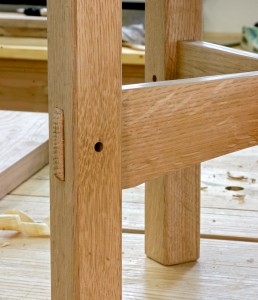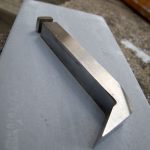We may receive a commission when you use our affiliate links. However, this does not impact our recommendations.
 Most woodworkers have an idea of what quartersawn wood is. The accepted definition is that the growth rings are between 60° and 90° to the wide face of the board. In some species, notably white oak, this exposes the medullary rays and changes the figure from “that’s nice” to WOW!”
Most woodworkers have an idea of what quartersawn wood is. The accepted definition is that the growth rings are between 60° and 90° to the wide face of the board. In some species, notably white oak, this exposes the medullary rays and changes the figure from “that’s nice” to WOW!”
Where things fall apart is when people try to visualize how the saw blade passes through the log as the lumber is milled. I just did a Google image search on the term “quartersawn lumber” and 75 percent or more of the images are incorrect. The methods shown range from absolutely crazy to just plain silly. Like most things about the Internet, the right answer is there, you just need to find a qualified source.
Down the road from our offices here in Cincinnati is the Frank Miller Lumber Company, in Union City, Ind. Glen Huey documented a trip he and I made several years ago in this blog post, and we shot some video of their retail operation in this blog post. Frank Miller Lumber saws more white oak than anyone, and has for more than 100 years. The company recently released an animated video that shows how they do it in Union City. It’s nicely done and fun to watch.
Click Here to visit the Frank Miller Lumber web site.
my personal blog is at readwatchdo.com
Here are some supplies and tools we find essential in our everyday work around the shop. We may receive a commission from sales referred by our links; however, we have carefully selected these products for their usefulness and quality.










I grew up working in my grandpa’s sawmill where we sawed barrel staves and those are all quartersawn white oak. Basically what we did was buck the logs to a length of 38-40 inches. Once they were cut to length we would quarter the block with a spliter saw and send them down a chain belt to a band resaw. The band saw would cut a board off and at the end of the belt the quartered block was pushed off the board and placed on rollers that brought the block back around to the sawyer running the bandsaw. You would flip the block 90 degrees and run it back through the band saw. This would continue until you couldn’t get a 2″ board out of the block. Pretty interesting process. Before that my great grandpa would split staves. Spliting them means exactly that he would take a maul and a wedge and split barrel staves out of 40 inch blocks. Doesn’t that sound like a party?
Nothing like a trip to FML, and a stop in Greenville for Maid-Rites for lunch. Darrin, and Josh are great hosts, and through the week if it isn`t too busy, you might wrangle a tour.
Yes the animation was in super slow mo play of real life. The headsaw just barely slows between swing, and bumps in real time, it`s something to see. The woodworking version of Disneyland, plus to get back to the working area you get to walk by yards of really tall stacks of hardwood. A feast for the eyes, and the nose, makes for a fine day.
Hopefully I don`t get into trouble posting this, but if you are a member of http://westernohiowoodworking.org/ you buy at FML at a 25% off price. Pretty much the same price as Rockler, or WoodCraft would buy at. So if you are in central to SW Ohio it would be worth joining, if you make one trip to FML a year you would cover the cost easily, if you end up making 10 trips, well, it would be like printing your own money almost. 🙂
I know the images you are talking about, and as a hobbyist sawyer, they have always been annoying to look at. No one cuts a round log into quarters, then puts the quarters up at a 45-degree angle and saws through-and-through. I have a different method for quartersawing than the one in the video here, but it does present a reasonable way to do it. The only thing I scratch my head over is why the log is flipped end-for-end after each pass. I’m not aware of any mill that operates this way.